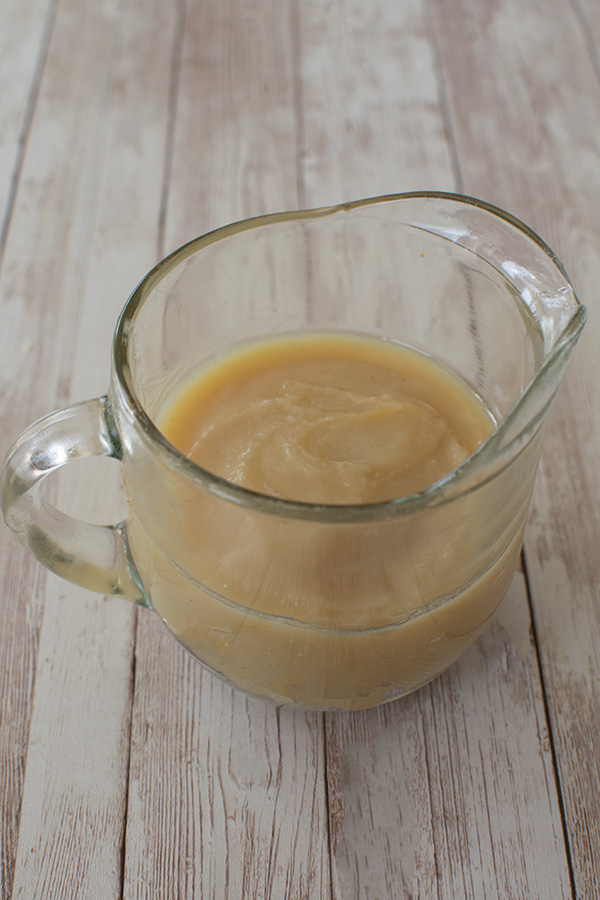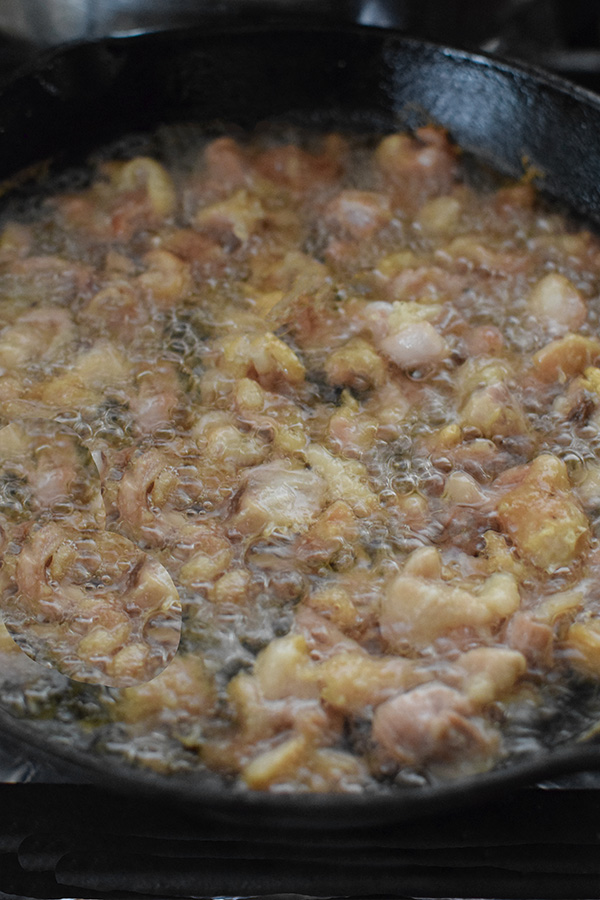Easy Onion Flavored Chicken Schmaltz is the onion flavored version of the traditional Ashkenazi (Eastern European) schmaltz.

Schmaltz is rendered (melted) chicken or goose fat that was used to grease by Eastern European Jews as they could not use lard (from pig) and they couldn’t use butter with meat (mixing meat and milk).
Shmaltz was introduced to the US by Eastern European Yiddish speaking Jews when they ran from European anti-Semitism and immigrated to the US, bringing their cuisine with them.
The term “schmaltz” is derived from the German verb meaning “to melt” and is used in Yiddish as well.
Today, the term is commonly used in English when referring to chicken fat as it relates to cooking. However, schmaltz came to refer to drippy, over-the-top dramatization of events or in shows or mushy sentimentality.
Today, schmaltz is used much less in cooking, but is still best to enhance some dishes, as it adds a little extra delicious greasiness to recipes that need it.
I personally use schmaltz with Easy Homemade Chicken Shawarma and Easy Homemade Turkey Shawarma, because, when making these at home, fat is missing, so the schmaltz helps.
Schmaltz is used by some people as a spread on bread or crackers.
While regular schmaltz is online 1 ingredient (and water), Easy Onion Flavored Chicken Schmaltz is a 2-ingredient recipe for chicken fat and fried onions.
Easy Onion Flavored Chicken Schmaltz is simple to make, but does takes a little time on the stove. It can last in the refrigerator for a long time.
A by product of the fat rendering product is “gribenes”, which are the crispy pieces of chicken skin left after the melting process. My grandmother used to take gribenes and chop it in when she made chopped liver.
Prefer schmaltz without the onion flavor? Easy Basic Chicken Schmaltz

A little of my cooking background
I really wanted to title this blog “If I can make it, anyone can” because, honestly, if I can make it, anyone can.
I never really liked cooking, and when I was single, a meal for me meant grilled cheese, eggs, tuna, or something else that didn’t require effort or time.
When my kids were young, I was still able to get away with preparing only a small variety of easy meals, but the older they got, the more dishes I learned to make at their request.
Still, I insisted on keeping it simple.
Honestly, I never understood why some cooks unnecessarily complicate meals. I have seen recipes that have several ingredients that don’t really seem to add much, if anything, to the dish. So, why bother?
It has always been important to me that whoever eats at my table will have plenty to enjoy, and that includes my kids (I never agreed with the “You will eat what is served or you won’t eat” ideology), and, because I keep it simple, I can prepare a variety of dishes in a relatively short period of time.
I have a philosophy regarding being a great cook: Prepare food according to the tastes of those who will be eating it, and they will love your cooking!
As far as I am concerned, start with the basic ingredients that make the dish what it is, adapt according to taste, and voila! You are an amazing cook!
The bottom line is that while there are certainly delicate recipes out there for specialty dishes, making delicious meals doesn’t have to be complicated or time-consuming. It’s not difficult to impress—just make sure it tastes good.
While some of the recipes on my blog are more time-consuming than others, they are all tried and true easy-shmeezy!
Of course, one always has to consider the conditions under which they cook. Weather (humidity, heat, cold), different types of ovens, different quality of pots, etc.—all of which can affect your cooking and baking.
Nevertheless, as I said, if I can do it, anyone can!
Everyday pantry essentials (suggested)
As I learned to prepare more and more recipes, I also learned which basics and seasonings are good to have on hand to have the ability to make a dish on short notice and not have to run out to the store or borrow from a neighbor.
While I will admit that I am not always prepared when one of my kids asks for eggplant parmesan or lasagna at the drop of a hat (which they have done), I dislike having to postpone making something just because the ingredients needed to make a reasonable meal were not readily available.
So, I maintain a selection of what I consider “pantry essentials” in my refrigerator and on my shelves at all times.
Initially, many of the herbs and spices were useful to me only on occasion (having been purchased for a particular recipe), and I usually just had them around as leftovers. However, as I began to cook more of a variety, I was really glad to have them (hey, look, I already have that!). And that is how my list began.
While, of course, most of the essentials will not be needed just for any one recipe, at least some of them are needed for most recipes, and you would be surprised how many recipes can be made just with this list. So, if you keep whatever you use regularly on hand, it can really save you time and effort.
Everyone has their favorite recipes, preferred seasonings, and just whatever they like to use to cook. Your own list should certainly reflect your own cooking tastes and style.
Just to give you an idea, the list below is a comprehensive list of what I normally keep on hand (this does not necessarily include what I keep for baking, and there may be some overlap between the two lists as some items are used for both, such as brown sugar), and, of course, it reflects the meals and desserts that I like to make for my own family and guests.
Seasoning and flavoring:
- salt (my recipes use regular table salt)
- ground black or white pepper
- granulated garlic or garlic powder (I prefer granulated)
- onion powder
- sweet paprika and/or sweet pepper flakes (paprika is ground dried red pepper, pepper flakes are crushed dried red pepper)
- hot paprika, hot pepper flakes, or cayenne pepper (moderately spicy dried ground chili pepper) for those occasional spicy dishes
- ground turmeric
- ground cumin
- ground cinnamon
- ground ginger
- ground nutmeg
- ground cloves (for pumpkin flavors)
- sugar (granulated)
- brown sugar
- chicken consommé powder / beef bouillon powder (regular or vegetarian)
- onion soup mix
- onion flakes (substitute for fresh onion—3 tablespoons for 1 medium onion).
- various herbs
- additional spices to adapt taste to preference
Misc:
- oil / margarine / butter / cooking spray
- coconut cream as a dairy-free cream substitute
- flavorless milk substitute as a dairy-free milk alternative
- cornstarch as a thickening agent
- flour
- baking powder
- baking soda
- bread crumbs or cornflake crumbs (you can make these with your blender or food processor) for coating
- condiments, such as ketchup, mustard, barbecue sauce
- tomato sauce/tomato paste/canned tomatoes—diced or crushed/pasta sauce
- soy sauce
- ready-made pie crusts and dough (to just add filling)
We always have eggs in the fridge and onions, rice, and potatoes on our shelves, as well as pasta.
In addition, having some fresh vegetables in the fridge, such as carrots, celery, tomatoes, bell peppers (various colors), etc., can be very useful when putting together a quick but delicious meal.
It is also a good idea to have some ground meat or chicken (breast, ground, or in parts) in the freezer for anyone who likes meat dishes in a snap.
Weather can have an effect on some of the spices and on the chicken consommé powder, so I keep as many of the seasonings in the refrigerator or freezer as I can, and I keep everything tightly closed in containers (you will be surprised to know just how determined moths are at getting into sealed bags and how hot red pepper powder can attract little black bugs—YUCK!).
Therefore, store your items well.
Why are these pantry essentials beneficial to have on hand?
Personally, having the above ingredients in my kitchen is very advantageous, as I make a variety of dishes and use most of the items on the list regularly enough to warrant storing them. However, I do not store items for dishes that I make seasonally or only on rare occasions or those that spoil easily.
Whether or not it is workable for you depends on your cooking style, the space you have to store, and whether or not you mind running out to the store as needed. Of course, the more you cook and the more varied your recipes, the more you will use and the more you will need.
Easy Onion Flavored Chicken Schmaltz

Easy to make-at-home, chicken schmaltz. Great for Jewish cooking or spreading on bread or crackers.
Instructions
- Chop chicken skin and fat into small. pieces.
- Also, chop onion into small pieces.
- Add the skin, fat, and water to a frying pan that has not been heated and place on medium heat.
- Cook on medium heat until the skin begins to turn a golden brown and then add the chopped onion.
- Fry, stirring frequently until the onion has lightly browned (approximately 10 minutes or so).
- Remove from heat and strain mixture into a container to separate skin and onion pieces from the schmaltz.
- Let cool.
Nutrition Information:
Yield:
8Serving Size:
1Amount Per Serving: Calories: 263Total Fat: 23gSaturated Fat: 6gTrans Fat: 0gUnsaturated Fat: 15gCholesterol: 47mgSodium: 37mgCarbohydrates: 1gFiber: 0gSugar: 1gProtein: 12g